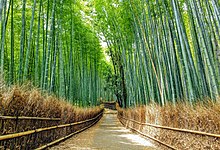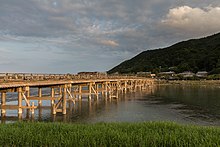Type a search term to find related articles by LIMS subject matter experts gathered from the most trusted and dynamic collaboration tools in the laboratory informatics industry.





Arashiyama (嵐山, Storm Mountain) is a district on the western outskirts of Kyoto, Japan. It also refers to the mountain across the Ōi River, which forms a backdrop to the district. Arashiyama is a nationally designated Historic Site and Place of Scenic Beauty.[1]
Arashiyama is a walkable area accessible by the Keifuku Electric Railroad (via Arashiyama Station (Keifuku)) from central Kyoto or by the Hankyū Arashiyama Line (via Arashiyama Station (Hankyu)) from Katsura Station, with connections from Osaka and Kyoto. Additionally, the JR Saga-Arashiyama Station is located in the district's suburbs.

Togetsukyō (渡月橋) is a bridge across the river. It is the subject of one of the Famous Views of the Sixty-odd Provinces ukiyo-e prints. The Japanese used mostly concrete in 1934 to rebuild the Togetsukyo Bridge, unlike the original destroyed wooden version of the bridge from 836.[2]
The river has three different names that denote its upper, middle, and lower stretches. It is called the Ōi River (大堰川, Ōi-gawa) in the upper course (not to be confused with the homophonously named Ōi River (大井川, Ōi-gawa), further to the east in Shizuoka Prefecture), the Hozu River (保津川, Hozu-gawa) in the middle course, and the Katsura River (桂川, Katsura-gawa) in the lower course.
35°00′54″N 135°40′14″E / 35.015096°N 135.670667°E (Arashiyama Park)
35°00′46″N 135°40′40″E / 35.012864°N 135.67775°E (Togetsukyō)
35°01′08″N 135°40′53″E / 35.018761°N 135.681389°E (JR Station)
35°00′56″N 135°40′42″E / 35.015437°N 135.678306°E (Randen Station)
35°00′35″N 135°40′56″E / 35.009859°N 135.682347°E (Hankyū Station)